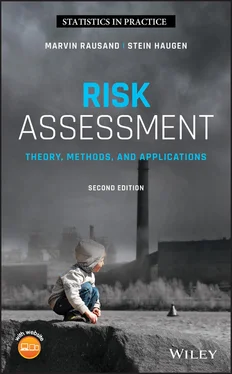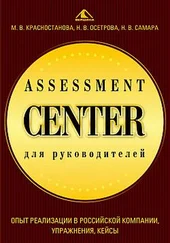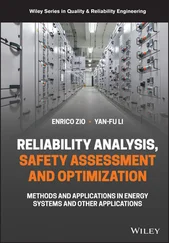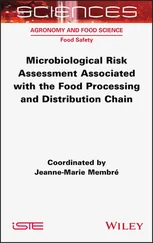Marvin Rausand - Risk Assessment
Здесь есть возможность читать онлайн «Marvin Rausand - Risk Assessment» — ознакомительный отрывок электронной книги совершенно бесплатно, а после прочтения отрывка купить полную версию. В некоторых случаях можно слушать аудио, скачать через торрент в формате fb2 и присутствует краткое содержание. Жанр: unrecognised, на английском языке. Описание произведения, (предисловие) а так же отзывы посетителей доступны на портале библиотеки ЛибКат.
- Название:Risk Assessment
- Автор:
- Жанр:
- Год:неизвестен
- ISBN:нет данных
- Рейтинг книги:3 / 5. Голосов: 1
-
Избранное:Добавить в избранное
- Отзывы:
-
Ваша оценка:
Risk Assessment: краткое содержание, описание и аннотация
Предлагаем к чтению аннотацию, описание, краткое содержание или предисловие (зависит от того, что написал сам автор книги «Risk Assessment»). Если вы не нашли необходимую информацию о книге — напишите в комментариях, мы постараемся отыскать её.
2nd Edition
The book begins with an introduction of risk analysis, assessment, and management, and includes a new section on the history of risk analysis. It covers hazards and threats, how to measure and evaluate risk, and risk management. It also adds new sections on risk governance and risk-informed decision making; combining accident theories and criteria for evaluating data sources; and subjective probabilities. The risk assessment process is covered, as are how to establish context; planning and preparing; and identification, analysis, and evaluation of risk.
also offers new coverage of safe job analysis and semi-quantitative methods, and it discusses barrier management and HRA methods for offshore application. Finally, it looks at dynamic risk analysis, security and life-cycle use of risk.
Serves as a practical and modern guide to the current applications of risk analysis and assessment, supports key standards, and supplements legislation related to risk analysis Updated and revised to align with ISO 31000 Risk Management and other new standards and includes new chapters on security, dynamic risk analysis, as well as life-cycle use of risk analysis Provides in-depth coverage on hazard identification, methodologically outlining the steps for use of checklists, conducting preliminary hazard analysis, and job safety analysis Presents new coverage on the history of risk analysis, criteria for evaluating data sources, risk-informed decision making, subjective probabilities, semi-quantitative methods, and barrier management Contains more applications and examples, new and revised problems throughout, and detailed appendices that outline key terms and acronyms Supplemented with a book companion website containing Solutions to problems, presentation material and an Instructor Manual
is ideal for courses on risk analysis/risk assessment and systems engineering at the upper-undergraduate and graduate levels. It is also an excellent reference and resource for engineers, researchers, consultants, and practitioners who carry out risk assessment techniques in their everyday work.

 is a property of the event
is a property of the event  , the experiment producing
, the experiment producing  , or a subjective probability that exists only in the individual's mind.
, or a subjective probability that exists only in the individual's mind. occurs more or less frequently, we often talk about the frequency of
occurs more or less frequently, we often talk about the frequency of  rather than the probability of
rather than the probability of  . Rather than asking “What is the probability of event
. Rather than asking “What is the probability of event  ,” we may ask, for example, “How frequently does event
,” we may ask, for example, “How frequently does event  occur?”
occur?” of such accidents during a period of length
of such accidents during a period of length  . A fatal traffic accident is understood as an accident where one or more persons are killed. The frequency of fatal traffic accidents in the time interval
. A fatal traffic accident is understood as an accident where one or more persons are killed. The frequency of fatal traffic accidents in the time interval  is given by
is given by
 may be given as calendar time, accumulated operational time (e.g. the accumulated number of hours that cars are on the road), accumulated number of kilometers driven, and so on.
may be given as calendar time, accumulated operational time (e.g. the accumulated number of hours that cars are on the road), accumulated number of kilometers driven, and so on. . We call this limit the rate of the event
. We call this limit the rate of the event  and denote it by
and denote it by  :
:
 have a true, albeit unknown value. The parameters are estimated based on observed values, and confidence intervals are used to quantify the variability in the parameter estimators.
have a true, albeit unknown value. The parameters are estimated based on observed values, and confidence intervals are used to quantify the variability in the parameter estimators.










